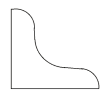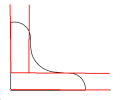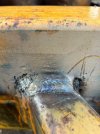Welder Dave
Senior Member
Oh no, that's what I expected. You're using about the worst wire possible unfortunately. E71T-GS doesn't even meet any AWS specs. E71T-11 does allow for multipass welds but it's still not designed for higher strength dynamic loads. E71T-GS is probably worse than welding with 6013 stick rods. Sorry for being a little harsh but you've got some big heavy pieces and you're welding them with wire designed for sheet metal and very light duty applications. In the field it's not too bad if it breaks but pulling it on the road at higher speed with a little bouncing could be really suspect. Kind of comparable to the tire with the cut on the sidewall. It holds air but would you trust it for long? It's too bad you didn't ask for recommendations on what wire or even type of machine to use before you started this project.
If your liner was arcing you should change it. It's possible it has arced on the inside as well and that is causing the wire to not feed properly when you first start.
If your liner was arcing you should change it. It's possible it has arced on the inside as well and that is causing the wire to not feed properly when you first start.




